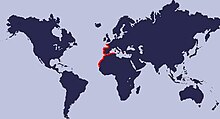Pollicipes pollicipes
| Pollicipes pollicipes | ||||||||||||
|---|---|---|---|---|---|---|---|---|---|---|---|---|

Pollicipes pollicipes |
||||||||||||
| Systematics | ||||||||||||
|
||||||||||||
| Scientific name | ||||||||||||
| Pollicipes pollicipes | ||||||||||||
| ( Gmelin , 1789) |
Pollicipes pollicipes is a species of barnacles in the class of barnacles that is found on the coast of the Eastern Atlantic. The barnacles live as sessile filter feeders on the hard surfaces of the rocks in the intertidal zone of the sea and on flotsam.
features
Like other barnacles, Pollicipes pollicipes consists of a flexible, muscular stem, the pedunculus, with which it is anchored to the solid substrate, and of the shell-like body or "head", the capitulum, which is covered by the two-lobed carapace . The whitish gray capitulum of Pollicipes pollicipes has a triangular shape and is covered with a larger number of limestone plates, which increases with age, for protection, in older animals up to over a hundred limestone plates. The crab has six pairs of thin, feather-shaped cirrus organs that are used to filter plankton from seawater. The stem of Pollicipes pollicipes can be 10 cm long.
Like other barnacles, Pollicipes pollicipes is hermaphroditic . The eggs are carried under the carapace in so-called ice bags. The hatching Nauplius larvae leave the carapace of the mother and develop into Cypris larvae after a pelagic phase. With the help of a cement gland located in the head, these attach themselves to a solid substrate and metamorphose into a sessile adult animal.
distribution
Pollicipes pollicipes is native to the eastern Atlantic on the coasts of France , Spain , Portugal , Morocco and around the Canary Islands and the Cape Verde Islands , south to Senegal and in the north also occasionally on the coast of England . In the Mediterranean there are only scattered occurrences. It lives in the intertidal zone on rocks, flotsam and shipwrecks.
Use by humans
The stem of the barnacles is eaten as a seafood - boiled in salt water or briefly steamed in oil . Harvesting is laborious and dangerous, as the barnacles can only be found in the intertidal zones that are difficult to access, i.e. H. can be found in the area where waves constantly hit the rock. The wilder the sea and the more unprotected the rock face exposed to it, the thicker and fleshy it is, and the more expensive the barnacles that can be found there. Customers in Spain and Portugal pay up to € 200 per kilo for the best quality percebes . On the fish markets of the Algarve in Portugal, barnacles are offered at a kilo price of € 15 to € 25 (as of 2015). The risky occupation of their fishermen, the percebeiros , is a topic in literature, films and reports. In Galicia , on Spain's Atlantic coast, there is a Percebes festival in different places every year.
mythology
When bird migration was previously unknown , it was thought that barnacle geese ( Branta leucopsis ) evolved from this crustacean, as it was never observed to nest in temperate Europe. The confusion was caused by the similarities in color and shape. In German, the goose even became a duck. Because they were often found on driftwood, it was believed that the barnacles were deposited on the branches of trees before falling into the water. The Welsh monk Giraldus Cambrensis even claimed in the 12th century to have seen barnacles develop from barnacles.
literature
- DT Anderson: Invertebrate Zoology , 2nd Ed., Oxford Univ. Press, chap. 13, p. 292, ISBN 0-19-551368-1
- Richard Stephen Kent Barnes et al. a .: The invertebrates - a synthesis. Cape. 8.6. Blackwell, Malden MA 2001, p. 191. ISBN 0-632-04761-5
- Richard C. Brusca, GJ Brusca: Invertebrates. Cape. 16. Sinauer Associates, Sunderland Mass 2003, p. 511. ISBN 0-87893-097-3
- J. Moore: An Introduction to the Invertebrates. Cape. 13. Cambridge Univ. Press, Cambridge 2001, p. 193. ISBN 0-521-77914-6
- Edward E. Ruppert, RS Fox, RP Barnes: Invertebrate Zoology - A functional evolutionary approach. Cape. 19. Brooks / Cole, London 2004, p. 605. ISBN 0-03-025982-7
- Joel W. Martin, George E. Davis: An Updated Classification of the Recent Crustacea (PDF; 756 kB) . In: Science Series. Natural History Museum of Los Angeles County, Los Angeles 39.2001. ISBN 1-891276-27-1 , ISSN 0076-0943
- José Molares, Juan Freire (2003): Development and perspectives for community-based management of the goose barnacle (Pollicipes pollicipes) fisheries in Galicia (NW Spain) (PDF; 241 kB) . Fisheries Research 65, pp. 485-492.
Web links
- MarLIN, Biodiversity & Conservation: A goose barnacle - Pollicipes pollicipes
- Short documentary about the work of a percebeiro
Individual evidence
- ↑ Percebes - one of the best delicacies from the sea. TAZ Kochblog, December 2007 ( Memento from April 12, 2013 in the web archive archive.today ).

